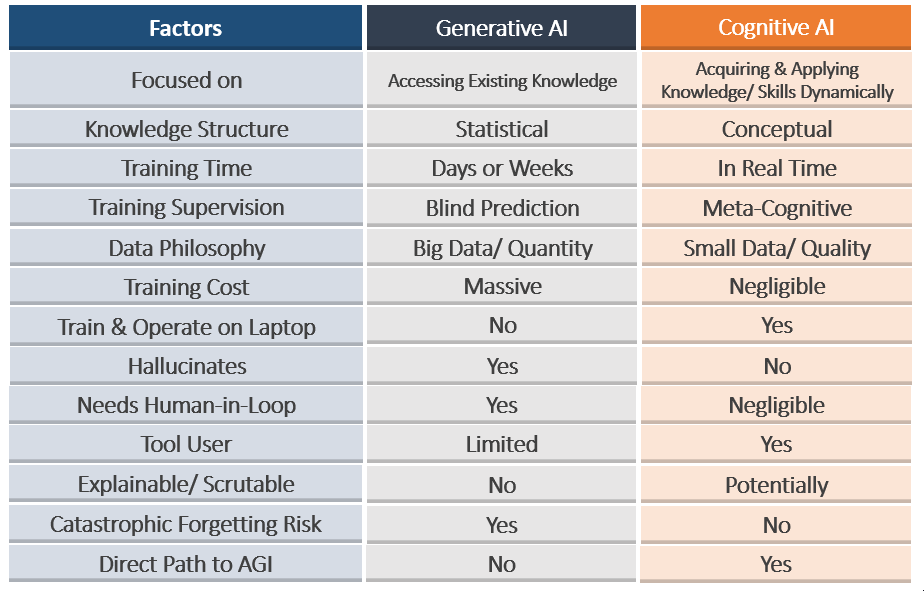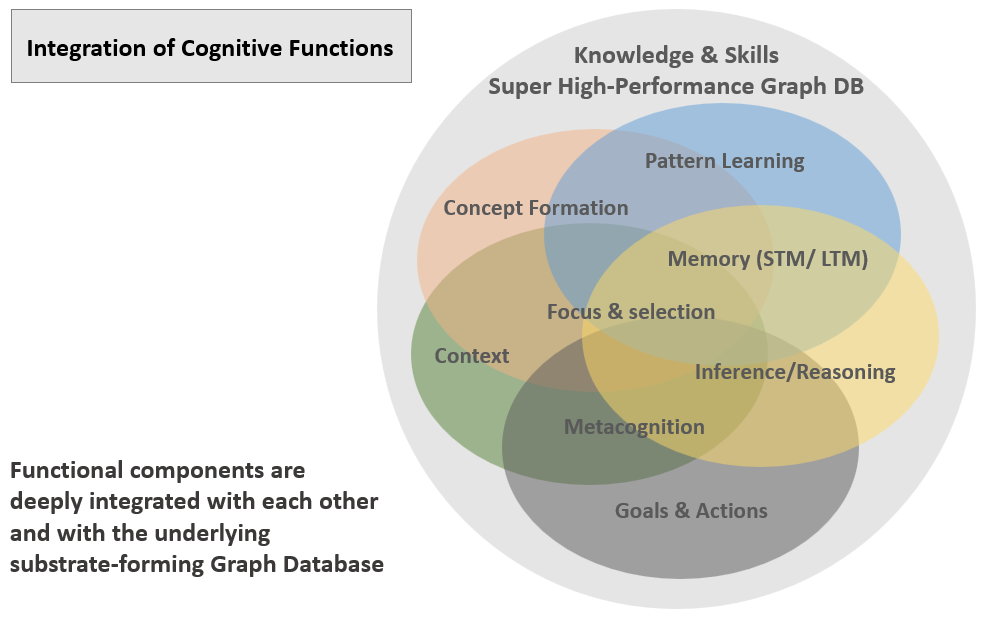Cognitive AI is an approach to AI (and AGI) that focuses on, and aims to implement the unique properties of human intelligence — those features that allow us to innovate and solve a wide range of problems in the real world. It stands in stark contrast to AI based on formal logic, and also those exploiting ‘big data’ and statistics.
A few years ago DARPA presented ‘The Three Waves of AI’ (ref), a useful categorization of three fundamentally different approaches to AI.

AI has come a long way.
Over the decades, combinations of various programming techniques have enabled slow spotty progress in AI — punctuated by occasional breakthroughs such as certain expert, decision and planning systems, and mastering Chess and Jeopardy! These approaches, and in particular those focused on symbolic representations, are generally referred to as GOFAI (Good Old-Fashioned AI) (wiki). Importantly, a key characteristic that they share is that applications are hand-crafted and custom engineered: Programmers figure out how to solve a particular problem, then turning their insights into code. This essentially represents the ‘First Wave’.
Starting in the early 2010’s, huge amounts of training data combined with massive computational power prompted a reevaluation of a particular 30-year-old neural network algorithm. To the surprise of many researchers this combination, aided by new innovations, managed to rapidly catapult these ‘Deep Learning’ (wiki) systems way past the performance of traditional approaches in several domains — particularly in speech and image recognition, as well as most categorization tasks.
More recently, the introduction of ‘Transformers’ (wiki) plus another significant increase in training data (now more than 10 trillion words!) and ‘compute’ have achieved phenomenal success in several areas of natural language processing and image generation — a field now called ‘Generative AI’ (wiki).
This tsunami of progress is worthy of the title ‘The Second Wave’.
AI has a long way to go.
In spite of this recent progress, AI has a long way to go to approach full human-level adaptive learning, abstract reasoning, and autonomous problem solving ability — a goal known as AGI (Artificial General Intelligence). Today’s Generative AI systems suffer a number of serious limitations, among them their inherent propensity to hallucinate, their inability to update their core model incrementally in real-time, the constant need for a ‘human in the loop’, plus their massive data and resource requirements. There is widespread consensus that these purely statistical models alone will not get us to AGI.
Enter ‘The Third Wave’. Cognitive AI starts with questions about human intelligence. Ideally it is based on a deep integrated understanding of key subfields of cognitive science: philosophy, cognitive psychology, and computer science.
In Philosophy: How do we know reality? What is certainty? Where does free will fit in? And consciousness? Even: How do we know good from bad?
From Psychology: How do children learn? What do (or should) IQ tests measure? Where do emotions fit in? How does our intelligence differ from animals?
Computer science: What are our specific goals, and are we on a clear path to achieving them? What can we learn from seven decades of AI R&D? What are major issues with ‘Narrow AI’? What promising approaches haven’t panned out, and why?
A synthesis of answers to these, and many more related questions should be the foundation for building machines that can match and exceed human cognition at its best.
Key attributes of human intelligence.
Intelligence is the cognitive ability to understand the world; to help achieve a wide variety of novel goals; and to autonomously integrate, adapt and re-use such knowledge and skills via ongoing incremental learning. It needs to function in real time, in the real world, and with limited knowledge, time, and resources.
What sets human intelligence apart is our unique ability to recursively form abstract concepts on top of existing abstractions — to end up with highly abstract ideas such as ‘honor’, ‘financial derivatives’, or the ‘time travel paradox’ (wiki). This core feature is also the key to both our ability to learn language and to our relatively high level of self-awareness.
There’s a lot more to be unpacked about the key requirements of high-level intelligence but let’s just summarize some of the more obvious ones:
For an AI to be able to respond to the dynamics of real-world changes and interactions it absolutely needs to be able to learn and integrate new knowledge (including skills) incrementally, in real time. It needs to be able to update existing knowledge and infer new implications as additional information becomes available. Furthermore, it must be able to do this autonomously in a goal-directed manner, and with potentially incomplete or contradictory data and limited time. Finally, it requires metacognitive awareness and oversight of its cognitive processes, something also called ‘System 2 thinking’ (wiki).
These requirements differ significantly from what Statistical AI offers

How can Cognitive AI be instantiated?
Cognitive AI is typically implemented via a ‘Cognitive Architecture’ (wiki) or ‘artificial brain’, which may be deployed in a robot or as a stand-alone computer program.
Our research (and practical commercial applications) have shown that for a cognitive architecture to function properly it needs to have all of its cognitive components deeply integrated with each other and with the underlying knowledge representation. We developed a super high-performance graph database (1000 times faster than best commercial graph DB) plus all of the requisite integrated cognitive algorithms. This system, including some benchmarks are detailed in our whitepaper.

Cognitive AI does seem to meet all of the requirements of AGI.
Unfortunately, through an accident of history very little money and effort is currently supporting this ‘Third’ (and final) wave: Impressive advances and financial momentum with Statistical and Generative (second wave) AI over the past decade or so have created a monoculture of investments and research, and ‘sucked all of the oxygen out of the air’. In this environment previous Cognitive AI efforts have all but stalled with only a handful of companies continuing to do meaningful commercial and developmental work.
We expect this situation to change in the near future as more companies and investors come to accept the inherent limitations of Generative AI, to more fully appreciate AGI’s enormous benefits to humanity, and to begin to recognize Cognitive AI as the viable path to achieving it.
